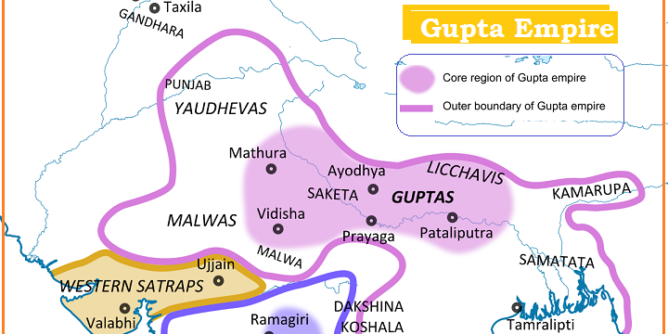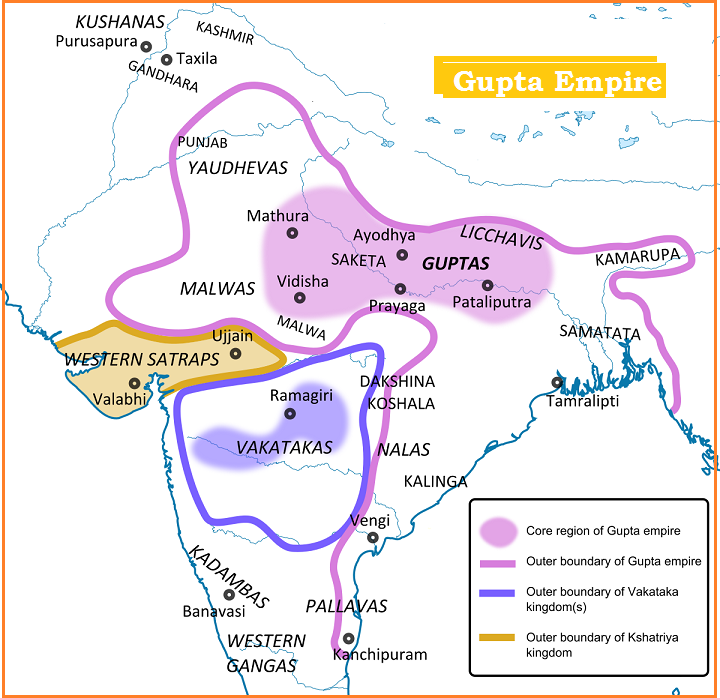
After the disintegration of Maurya Empire, the Satavahans and the Kushans acted as stabilizing factor in Deccan and in North India respectively (till 3 century AD). On the ruins of both empires, the feudatories of Kushans- Gupta Empire arose with their capital at Prayag, who had certain material advantages of their position because of the fertile and iron ore rich area and being in silk trade route to Roman Empire.
The Gupta period is called as ‘the Golden Age of Ancient India’. They kept India politically united for more than a century.
Srigupta founded the empire who was succeeded by his son Ghatotkacha whose details are not available.

Chandragupta I:
- The grandson of Srigupta, Chandragupta I (319-334 AD) was the first important king, who married a Lichhvi princess Kumar Devi (Nepal).
- They were possibly Vaishyas and therefore, it strengthened their position being married to a kshatriya.
- He started Gupta Era in 319-20 AD, which marked the date of his accession.
- Vishakhadatta’s Mudrarakshasha (‘ring of demon’) narrates the ascent of Chandragupta Maurya to throne.
Samudragupta: (335- 380 AD)
- Son of Chandragupta I succeeded, who resorted to the policy of aggressive conquests.
- He unified the greater part of India from Punjab to Kanchi (Pallavas accepted his suzerainty), and from Afghanistan to Nepal and Assam.
- His bravery and generalship earned him the title of ‘the Napolean of India’. He assumed the title of Vikramaka.
- His court poet Harishena provided a glowing account of military conquests in Allahabad Inscriptions (Prayag Prashasti).
- His prestige and influence spread outside India. According to a Chinese source, Meghavarman, the ruler of Sri Lanka, sent a missionary to him for permission to build a Buddhist temple at Gaya.
- He proudly described himself Lichhavidauhitra in some inscriptions owing to his maternal links.
- Chinese pilgrim Huen Tsang visited during his kingdom and found that monks are given ample hospitality.
Chandragupta II:
- Chandragupta II (380-412 AD) reign saw the high watermark of the Gupta Empire. He extended the limits of empire through cultural conquest and marriage alliances.
- He married the princess of Vakataka dynasty and his daughter Prabhavati to Rudrasen II.
- Controlled the Central and Western Indian parts of Gujarat and Malwa (which were under Shaka Kshatraps), Ujjain and the west coast (famous for trade and commerce).
- He made Ujjain the chief city of Malwa his second capital, which was adorned by scholars like Kalidasa and Amarsimha among others as Navratnas.
- Devi Chadraguptam of Vishakhadatt gives an account of defeating the Saka king by him to prevent surrendering Druvadevi, the wife of his brother Ramagupta to Sakas.
- Conquest of Sakas was the most important event of his reign. He defeated the Saka king Rudrasena III and annexed his kingdom.
- He adopted the title of ‘Vikramaditya’, which was first used in 58 BC to mark his victory over Sakas.
- During his time, Chinese pilgrim Fa-hien visited India and wrote an elaborate account of Gupta period.
Kumargupta I:
- Son of Chadragupta II, also known as Mahedraditya ruled for about 40 years.
- His reign suffered severely from Huna invasion.
- Issued coins bearing killing lion and Kartikeya.
- Udayagiri Inscriptions speak about Chandragupta II and Kumargupta.
Skandgupta:
- Last powerful ruler, Bhitari inscriptions and Junagarh Rock inscriptions details about his power and kingdom.
Polity
- They had Vaishya
origin and made gifts and grants
to Brahamanas became a regular affair to get their gratitude.
- Fiscal and administrative concessions were also granted to administrators.
- They were authorized to collect taxes from the peasants and even empowered to punish the criminals.
- The major part of the empire was held by feudatories who had certain
obligations to the king.
- Obligations include offering homage, paying tribute and marrying daughters to the king.
- They organised a system of provincial and local
administration. The empire was divided
into Divisions (Bhukti) under the charge of Uparika, Districts (Vishaya) under Vishayapati, sub- districts (Vithis) and villages.
- The Village headmen (Grampati or Kutumbis or Maharattas) became more important in Gupta Empire.
- They did not interfere in those regions which accepted the suzerainty of Guptas.
- There was an efficient administration in Gupta
Empire. The king was assisted by a council of ministers.
- Kumaramatyas were the most important officers in charge of a division, who were appointed by the king directly and paid in cash.
- Mahabaladhikrita was the commander in chief.
- The judiciary was far more developed under them
and several law books were compiled,
first time civil and criminal laws were demarcated. However, it was based on
differences in Varnas.
- The supreme judicial power was invested in the king but the judicial functions were carried out by Mahadandnayaka.
- However, the bureaucracy was not much elaborate, also because they did not regulate economic activities like Mauryas.
- The professional bodies were organised into guilds and had considerable share in urban administration. They had their own laws for punishing power a member of their guild.
- They maintained a standing army, which was to be supplemented from that of his feudatories in need. Cavalry and horse archery became important and chariot receded into the background. Horsemen are often represented on the Gupta coins.
Economy
- They had many taxes as in Mauryan period. They issued largest number of gold and silver coins and were paid in cash and land grants too.
- During Gupta period, the land taxes increased
and those on trade and commerce decreased leading to declining of several
towns. Some of taxes were:
- Bali: compulsory in Gupta era
- Bhaga: king’s share in produces
- Hiranya: paid in gold
- Shulka: custom or toll tax
- They did not regulate economic activities on any big scale like that of Mauryans.
- The grant of tax-free land with administrative concessions became a regular affair and there was emergence of priestly landlords (especially in Central India) who brought many virgin areas under cultivation.
- However, there was a decline in long- distance trade to Roman Empire who had learnt the art of making silk from the Chinese and silk weavers had to abandon their occupation.
- In Central and Western India the villagers were also subjected to forced labour called Vishti for serving the royal army and officials.
Religion & Society
- Brahamana supremacy continued who expressed their gratitude to the Vaishya kings. They claimed many privileges listed in the law-book of Narada.
- Many foreigners were assimilated into the Indian society who was given the status of Kshatriyas (Hunas into Rajput) and also tribals through land grants. This resulted in many sub castes.
- The position of Shudras improved a little, they were represented as agriculturists and were permitted to listen to the religious texts and worship a new God- Krishna. However, the untouchables increased in number, especially the Chandalas who dealt with meat and flesh and lived outside the villages (Fa-hsien’s Account).
- The position of women also improved and lower varna women had independent sources of livelihood and considerable freedom than that of higher order women.
- Buddhism no longer received royal patronage, however they followed a policy of religious tolerance and Bhagvatism which was centered on worship of Vishnu or Bhagavat grew.
- Vishnu emerged as the savior of varna system.
- It was marked by Bhakti and Ahinsa, which appealed to the agricultural society and liberal enough to attract artisans, merchants and foreigners.
- Later in the 6 century, Vishnu became a member of Trinity of Gods along with Shiva and Brahma. Idol worship became common practice in this period.
- Idol worship in the temples became a common feature of Hindu worship. Agricultural festivals were also given religious garb.
- The Shakti cult emerged with the worship of consorts of Indian Gods: Laxmi, Duga, Kali became prevalent during Gupta era.
- The six schools of Indian philosophy started taking definitive shape because of philosophical debates between Hindu and Buddhists on the question of God, Mokshya, etc.
Fall of Gupta Empire
- His successors could not cope with the invasion of Hunas from steppes of Central Asia. Hunas were excellent archers and move quickly to occupy up to Malwa.
- Rise of feudatories and loss of sources of revenue and trade.
- Large scale grants and concessions to priest and administrators which made it difficult to maintain a large professional army.
- Absence of law of primogeniture along with strong centralized authority made the kingdom weak gradually as there were wars for the throne.
The disintegration of Gupta empire (6 century AD) paved the way for many smaller kingdoms like Aulikara (Malwa), Gurjars (Gujarat), Maukharis (UP), Gauda (Bengal), Barmans (Assam).
Art and Architecture

- They were patrons of art and literature. Gupta period is called as ‘the Golden Age of Ancient India’.
- Samutragupta is represented in his coins with vina. Chandragupta II had nine great scholars (Navratna) in his court including Kalidasa and Amarsimha.
- Buddhism gave impetus to art and architecture post Mauryan period. Bronze and copper images of Buddha were made and Ajanta paintings marked by brilliance of their colors which were based on the life of Buddha are the greatest specimen of Buddhist art in Gupta Empire.
- For the first time images of Hindu Gods were created.
Temple Architecture:

- Hindu temple architecture was in its formative stage but was the first dynasty to build permanent free-standing Hindu temples and only few temples made up of bricks were created. Bhitargaon (Kanpur) Temple and Deogarh (Jhansi) are such examples. The walls were decorated with sculptured deities, decorative motifs and scenes from everyday life too.
- The earliest stone temple built was Dasavatar Temple, Deogarh (Jhansi) which has no shikhara. The Nagara style of temple architecture started developing.
- The earliest structure of Nalanda University created during this period was also a brick structure. Nevertheless, the influence of Gupta-era buildings on later Indian temple architecture is indisputable.
Cave Architecture:

- The earliest examples of religious architecture were cave-temples, which typically had exteriors decorated with relief sculpture and a single carved doorway.
- Chaitya and Vihara caves at Ajanta and the Ellora caves are the best specimens of cave architecture of the period.
- Ajanta Caves also contain some of the earliest and finest examples of Indian wall-painting based on the life of Buddha.
Literature:
- It was a bright phase for the development of classical literature and many secular as well as religious works were created in this period.
- The ornate style was developed and greater emphasis was given to verse than earlier prose style.
- Kalidasa was a court poet in Chandragupta II court, whose literary works include Abhigyan Sakuntalam, Meghdut, etc. Kamasutra depicts the urban life in detail.
- The court had Navratnas or nine jewels:
- Amarsimha: Amarkosha (Sanskrit Dictionary)
- Dhanvantari: physician
- Harisena: poet (Allahabad Inscriptions)
- Kalidasa: poet (Abhigyan Sakuntalam, Meghdut, Malvikaagnimitram)
- Kahapanka: astrologer
- Sanku: architecture
- Varahamihira: mathematician, astrologer
- Varauchi: Prakrit Prakasha (Prakrit Grammar)
- Vetalbhat: magician
- Remarkable characteristics of the literature of this period are- love or comedy theme and use of different languages for higher classes (Sanskrit) and lower classes (Prakrit)
- Gupta period also saw a rise in religious literature. Mahabharat and Ramayana were completed in this period. Various law books, Puranas were compiled.
- Manu’s Dharmashastras were written. Yajnavalkyasmriti is regarded as the official law book of Gupta period.
Science and Technology

- Gupta period also saw the development of science and technology with many scientific works and knowledge of technology to credit.
- Great mathematicians like Aryabhatt, Bhaskaracharya, Varahamihira belong to this period and many texts on mathematics, and astrology were written.
- They had the knowledge of advanced metal technology and many copper and bronze images were produced.
- The iron pillar of Mehrauli (Delhi) was manufactured in this period, which has not rusted after 15 centuries. It is also known as Garuda Pillar with inscriptions of Chandragupta II.

 Home
Home Syllabus
Syllabus Contact Us
Contact Us




